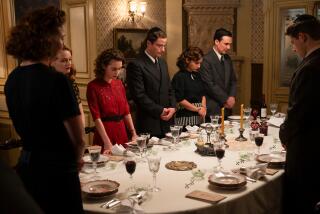BOOK REVIEW: NONFICTION : A Modern Update on an Ancient People : A CHOSEN FEW The Resurrection of European Jewry <i> by Mark Kurlansky</i> , Addison-Wesley $24, 432 pages
- Share via
“A Chosen Few,” Mark Kurlansky has taken on the monumental task of exploring the present state of Jewish community life in France, Germany, Hungary, the Netherlands, Slovakia and the Czech Republic, Russia, Belgium and Poland, countries where individual and collective suffering during the Holocaust virtually obliterated an entire culture.
Much of what he discovered is heartening, despite the fact that the current European Jewish population of 4 million stands at somewhat more than half the number who lived on the Continent before World War II. Even so, Kurlansky finds cause for joy in Paris and Antwerp, for satisfaction in Budapest and for guarded optimism in Amsterdam, Prague and Berlin, as well as in many smaller cities. Poland offers nothing to gladden his heart, and the nations of the former Soviet Union, once briefly hospitable to refugees from Axis-dominated countries, have long since become as hostile as ever.
Kurlansky interviewed more than 100 Jewish returnees, inquiring into their motives, reporting their successes or failures, and meticulously chronicling their arduous readjustment to a society where they suffered unspeakable agonies and saw relatives and friends die frightful deaths. He spoke to intellectuals and workers, atheists and rabbis, the observant and the indifferent, the politically active and the apathetic, introducing the reader to an enormous variety of people.
Some appear in brief vignettes, their stories condensed into a paragraph or two; others are followed through marriages, changes of career and movement from one country to another. Kurlansky is always patient, never judgmental. Although his subject may be specialized, his relaxed conversational style and astute political insight broaden the book’s appeal.
He describes the changing nature of these communities, paying particular attention to Paris, where the influx of North African Jews has radically altered the aspect of a once predominantly Ashkenazi and bourgeois population.
The side streets leading from the Place de Vosges now have a distinctly North African ambience, as the original Eastern European immigrants and French artisans have prospered and moved on to other neighborhoods. The old district that was once both their home and workplace is now the trendy Marais, a prime tourist destination of restaurants, boutiques and freshly renovated museums, where Sephardic custom and ritual flourish behind the glamorous facades.
*
Readers unable to understand why Jews would return to Germany will find surprising answers here, as will those curious about the motives of people who choose to resettle in the perpetually unstable countries of the Eastern Bloc.
Many of the German returnees have created self-sufficient enclaves for themselves, notably in Duesseldorf, but elsewhere as well, seldom venturing into the world around them. A few have a sense of mission. Some are defiant, many are timid, all are wary.
A minority of the Eastern Europeans believed they could never adjust to a capitalist economy and lacked the skills necessary to compete. There are those who still wish to live in a paternalistic world, no matter how unpredictable or capricious the government. Others are professors, scientists, writers and performers who would be unable to work in their chosen fields outside of their own countries. For them, material deprivation is easier to bear than the risks of beginning life anew in a completely alien environment.
The sad tales of gifted violinists sweeping streets in Tel Aviv and skilled physicians reduced to working as hospital aides have drifted back to them, preventing many from leaving Hungary, Romania or the shattered Soviet Union. Some who emigrated have returned, disillusioned and homesick, preferring familiar unease at home to utter alienation away.
Although the individual stories necessarily have a great deal in common, they remain consistently absorbing. The similarity itself becomes one of the great strengths of the book, generating a cumulative power. In an admittedly crowded literary field, “A Chosen Few” investigates the relatively uncharted territory of an encouraging phenomenon.
More to Read
Sign up for our Book Club newsletter
Get the latest news, events and more from the Los Angeles Times Book Club, and help us get L.A. reading and talking.
You may occasionally receive promotional content from the Los Angeles Times.










